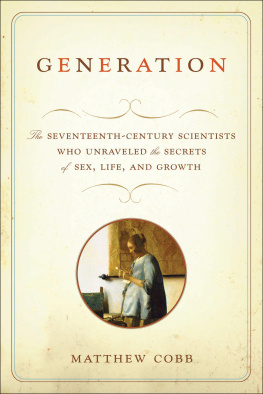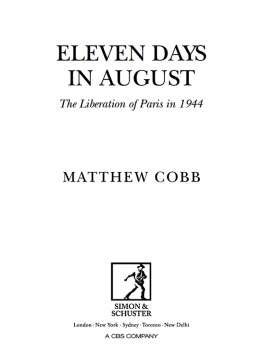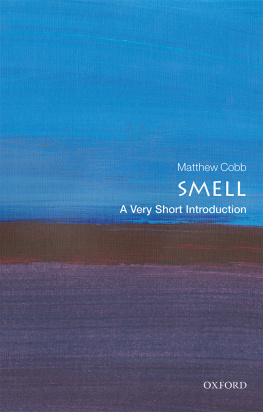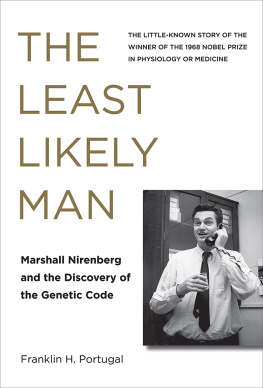Matthew Cobb is a respected scientist and historian, and he has combined both disciplines to spectacular effect in this compelling, authoritative and insightful account of how life works at the deepest level. Its a bloody brilliant book. Professor Brian Cox
Lifes Greatest Secret is the logical sequel to Jim Watsons The Double Helix. While Watson and Crick deserve their plaudits for discovering the structure of DNA, that was only part of the story. Beginning to understand how that helix works how its DNA code is turned into bodies and behaviours took another fifteen years of amazing work by an army of dedicated men and women. These are the unknown heroes of modern genetics, and their tale is the subject of Cobbs fascinating book. Jerry Coyne, University of Chicago and author of Why Evolution is True
Most people think the race to sequence the human genome culminated at the 2000 White House Mission Accomplished announcement. In Lifes Greatest Secret, we learn that it was just one chapter of a far more interesting and continuing story. Eric Topol, Professor of Genomics and Director, Scripps Translational Science Institute and author of The Patient Will See You Now
Gripping, insightful history, often from the mouths of the participants themselves. Kirkus Reviews
Rich, thrilling and thorough, this is the definitive history of arguably the greatest of all scientific revolutions. Adam Rutherford, science writer, broadbcaster and author of Creation
Writing with flair, charisma and authority, this is Cobbs magnum opus. But more important than that, this is humankinds magnum opus. This is the story of a great human endeavour a global adventure spanning decades which unravelled how life really works. No area of science is more fundamental or more important; read about it and be filled with wonder. Daniel M. Davis, author of The Compatibility Gene
Cobb reveals the astonishing drama of the moment genetics and information technology collided, shaping the modern world and modern thought. Paul Mason, Channel 4 News
ALSO BY MATTHEW COBB
The Egg and Sperm Race: The Seventeenth Century
Scientists who Unravelled the Secrets of Sex, Life and Growth (published in the US as Generation)
The Resistance: The French Fight Against the Nazis
Eleven Days in August: The Liberation of Paris 1944

Copyright 2015 by Matthew Cobb
First published in Great Briain in 2015 by
Profile Books Ltd
3 Holford Yard
Bevin Way
London wc1x 9hd
www.profilebooks.com
Published by Basic Books, A Member of the Perseus Books Group
All rights reserved. Printed in the United States of America. No part of this book may be reproduced in any manner whatsoever without written permission except in the case of brief quotations embodied in critical articles and reviews. For information, address Basic Books, 250 West 57th Street, 15th Floor, New York, NY 10107.
Books published by Basic Books are available at special discounts for bulk purchases in the United States by corporations, institutions, and other organizations. For more information, please contact the Special Markets Department at the Perseus Books Group, 2300 Chestnut Street, Suite 200, Philadelphia, PA 19103, or call (800) 810-4145, ext. 5000, or e-mail .
Typeset in Palatino by MacGuru Ltd
Library of Congress Control Number: 2015937254
ISBN: 978-0-465-06266-9 (e-book)
10 9 8 7 6 5 4 3 2 1
In memory of John Pickstone (19442014)
historian, colleague, friend.
CONTENTS

The RNA genetic code, as finally established in 1967. U, C, A and G are the RNA bases. The 20 naturally occurring amino acids are given in the table, as three-letter abbreviations (e.g. Phe = phenylalanine). In RNA, Uracil (U) replaces the Thymine (T) base found in DNA. AUG codes for both methionine (Met) and for the start of the message. Slight variants of this code are found in some species, and in the mitochondria that are found in our cells see .

An outline of how the genetic code works during protein synthesis. A DNA double helix in the cell nucleus is partially unravelled and one strand is transcribed into RNA (mRNA). In organisms with a cell nucleus, this mRNA often contains irrelevant sequences (introns) that are spliced out to form mature mRNA which then leaves the nucleus. In the cells cytoplasm, RNA-based ribosomes read the message, beginning at AUG. Transfer RNA (tRNA) molecules, synthesised by the cell from its DNA, carry on one side an anti-codon that binds with a particular mRNA codon and, on the other side, a binding site that links to a specific amino acid. In a process known as translation, tRNA molecules attached to an amino acid shuttle through the ribosome, bind with the mRNA codon and release their amino acid, thereby creating a protein chain.
AUG
In April 1953, Jim Watson and Francis Crick published a scientific paper in the journal Nature in which they described the double helix structure of DNA, the stuff that genes are made of. In a second article that appeared six weeks later, Watson and Crick put forward a hypothesis with regard to the function of the bases the four kinds of molecule that are spaced along each strand of the double helix and which bind the two strands together. They wrote: it therefore seems likely that the precise sequence of the bases is the code which carries the genetical information.
This phrase, which was almost certainly the work of Crick, must have seemed both utterly strange and completely familiar to those who read the article. It was strange because nothing so precise had ever been said before no one had previously referred to genetical information. This was a category that Watson and Crick had just invented. And yet it was familiar because it fitted so well with the ideas that were in the air at the time. It was adopted without debate; this new way of looking at life seemed so obvious that it was immediately accepted by scientists around the world. Today, these words, or something like them, are said every day in classrooms all over the planet as teachers explain the nature of genes and what they contain.
This book explores the surprising origin of these ideas, which can be traced back to physics and mathematics, and to wartime work on anti-aircraft guns and signals communication. It describes the way in which these concepts entered biology through the then-fashionable field of cybernetics, and how they were transformed as biologists sought to understand lifes greatest secret the nature of the genetic code. It is a story of ideas and experimentation, of ingenuity, insight and dead-ends, and of the race to make the greatest discovery of twentieth-century biology, a discovery that has opened up a brave new world for the twenty-first century.
Next page









